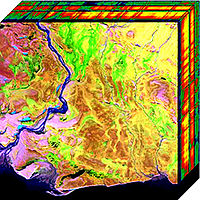
3-D Time-Domain Airborne EM Forward Modeling With IP Effect Based on Implicit Difference Discretization of Caputo Operator
Sign Up to like & getrecommendations! Published in 2022 at "IEEE Transactions on Geoscience and Remote Sensing"
DOI: 10.1109/tgrs.2022.3225226
Abstract: As an efficient geophysical exploration method, the time-domain airborne electromagnetic (AEM) data often show sign reversal in late-time channels due to induced polarization (IP) effect. The traditional imaging and inversion methods without considering the IP… read more here.
Keywords: time; effect; domain airborne; effect based ... See more keywords

Spectral-element method with arbitrary hexahedron meshes for time-domain 3D airborne electromagnetic forward modeling
Sign Up to like & getrecommendations! Published in 2019 at "GEOPHYSICS"
DOI: 10.1190/geo2018-0231.1
Abstract: Mainstream numerical methods for 3D time-domain airborne electromagnetic (AEM) modeling, such as the finite-difference (FDTD) or finite-element (FETD) methods, are quite mature. However, these methods have limitations in terms of their ability to handle complex… read more here.
Keywords: time; spectral element; domain airborne; time domain ... See more keywords

Fast imaging of time-domain airborne EM data using deep learning technology
Sign Up to like & getrecommendations! Published in 2020 at "Geophysics"
DOI: 10.1190/geo2019-0015.1
Abstract: Due to the huge amount of data generated by time-domain airborne electromagnetic (AEM) systems, conductivity depth imaging methods are widely used to help in the interpretation of these data because they can be generated quickly… read more here.
Keywords: domain airborne; using deep; network; time domain ... See more keywords

Three-Dimensional Anisotropic Inversions for Time-Domain Airborne Electromagnetic Data
Sign Up to like & getrecommendations! Published in 2021 at "Minerals"
DOI: 10.3390/min11020218
Abstract: Rocks and ores in nature usually appear macro-anisotropic, especially in sedimentary areas with strong layering. This anisotropy will lead to false interpretation of electromagnetic (EM) data when inverted under the assumption of an isotropic earth.… read more here.
Keywords: inversion; anisotropic; domain airborne; time domain ... See more keywords